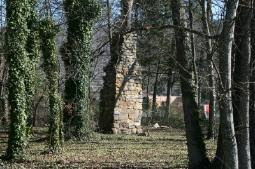 |
| DeSoto Falls |
One of the most spectacular and easiest to access of these is DeSoto Falls, part of DeSoto State Park. Located on the outskirts of Mentone and just a few miles from I-85 and Fort Payne, the waterfall is 100-feet high and is both a scenic wonder and a historic site rich in the heritage and culture of North Alabama.
Archaeological evidence indicates that prehistoric Indians frequented the waterfall area long before the first Europeans arrived in North America. Some researchers also say that the famed "Welsh Caves" at the falls date from the Woodland era and are more than 1,000 years old. Others, however, say they were excavated by the Welsh explorer Prince Madoc, who some believe explored Alabama in 1170 A.D.
 |
| Azalea Cascade at DeSoto State Park |
Better known is the role of the waterfall area during the Civil War. As the Union army was advancing on Chattanooga during the days before the Battle of Chickamauga, the 20th (XX) Corps) crossed Lookout Mountain at Mentone and cavalry forces are known to have visited the waterfall itself. The waterfall was also the site of one of the earliest hydroelectric plants in Alabama.
While DeSoto Falls is the largest, there are actually a number of other waterfalls in DeSoto State Park and they flow at their best during the winter months. The park also features cabins, camping, picnicking, a boardwalk that leads to a nice little waterfall, restaurant, hotel/lodge and more. Here are some links you might enjoy exploring for history, photos and more information:
- Desoto Falls: www.exploresouthernhistory.com/desotofalls1
- Desoto State Park: www.exploresouthernhistory.com/desotopark1
- Desoto State Park in Winter: www.exploresouthernhistory.com/desotowinter
- Mentone, Alabama: www.exploreosuthernhistory.com/mentone
- Fort Payne, Alabama: www.exploresouthernhistory.com/fortpayne



